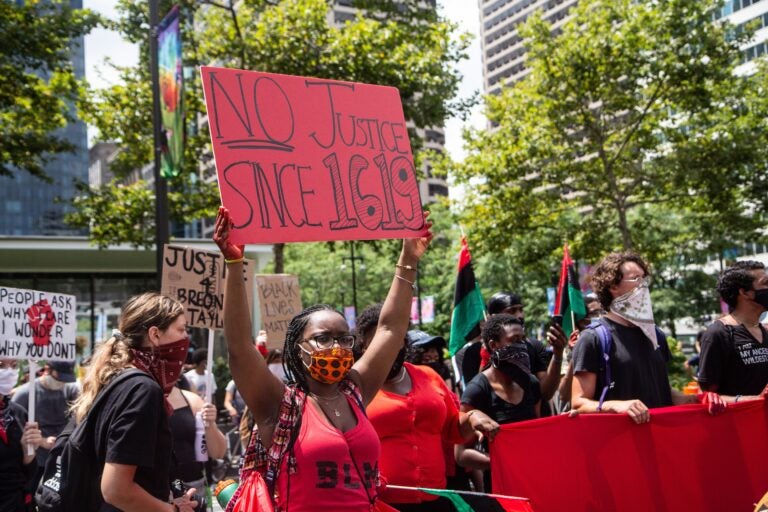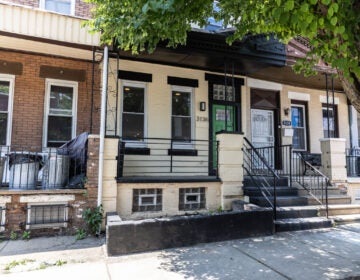Reparations would help cities. Now is the time for urbanists to advocate for them.
It’s time for cities to take a reparative framework that addresses impacts of past harm.

Protesters held a rally for reparations and racial justice on the Fourth of July outside Philadelphia’s Municipal Services building. (Kimberly Paynter/WHYY)
Katrina Johnston-Zimmerman’s recent column on how white urbanists can best use their privilege resonated with me. I am truly grateful for her courage to step away from the fray and say some things to white people that I’ve wanted to say for pretty much my entire professional career. I was particularly excited that she referenced the need for a ”heart-centered city,” which sounds quite similar to the All-In Cities initiative I help to lead at PolicyLink, a national nonprofit research and action institute dedicated to advancing racial and economic equity headquartered in Oakland, California. I am proud that it is my job to work with community coalitions across the country, working inside and outside of government to — as she described — “drive the design, management, policy, and priorities through values of co-creation, compassion, and care for our fellow humans starting with those who need it most.” This goal epitomizes the PolicyLink definition of equity — just and fair inclusion into a society in which all can participate, prosper, and reach their full potential.
While I fully agree with Johnston-Zimmerman’s goals, her approach falls as flat as a room- temperature soda on a hot summer day: better than nothing, but not quite satisfying. Johnston-Zimmerman and the white urbanists whose attention she may have piqued with her article should be bolder and more creative in their solutions, especially given the profound urgency that this moment demands. Across all fields, including urbanism, now is the time for a serious conversation about the need for reparations and how to advance a reparative framework that addresses the impacts of past harm.
Why cities are adopting ‘reparative’ frameworks
The idea of reparations in this country is not new. It can be traced back to Special Field Order 15, which was issued by General William T. Sherman of the Union Army on January 16, 1865 in the final days of the Civil War. This edict was developed under the guidance of 20 Black community leaders in Savannah, Georgia where Sherman was stationed at the time. Special Field Order 15 included a provision where formerly enslaved Africans would receive portions of the 400,000 acres of land that had been seized from the treasonous white landowners in the South who had betrayed this country and seceded from the United States out of anger and frustration that they would no longer be able to own enslaved human beings as chattel.
General Sherman was able to understand the importance that the ownership of land, and the economic security that it provides, was critical if formerly enslaved Africans were ever truly going to be integrated into the American body politic. A shared understanding of the importance of redistributing land led Congress to pass An Act to Establish a Bureau for the Relief of Freedmen and Refugees on March 3, 1865, later known as the Freedmen’s Bureau. Regrettably, this agency was never appropriately resourced to accomplish the transformative goal with which it was tasked and, upon Abraham Lincoln’s assassination in April 1865, President Andrew Johnson opted to rescind Special Order 15 and return the seized land to the white Confederate traitors to the United States, rather than redistribute the land to the enslaved Africans that had risked their lives to fight to defend this country.
The failure to enact Special Order 15 and fully equip the Freedmen’s Bureau isn’t the only example of how failed government policies have prevented wealth-building opportunities for Black people in this country. For example, University of Pennsylvania Associate Professor Amy Hillier has written extensively about redlining, and the effect it has had on Black people here in Philadelphia. Redlining refers to the practice where banks and governmental institutions such as the Federal Housing Administration refuse to issue mortgages in Black neighborhoods. To be clear, the denial of these loans was not based on creditworthiness. Rather, they were based on the demographic composition of the neighborhood. Sadly, while redlining was banned with the Fair Housing Act of 1968, the residual impacts of the practice can still be felt to this day. Recent analysis by the Center for Investigative Journalism confirmed that racialized disparities in mortgage lending persist in Philadelphia. Similarly, research by Dr. Andre Perry at the Brookings Institution has revealed that homes in Black neighborhoods continue to be assessed on average $48,000 less than comparable homes in majority white neighborhoods, causing a cumulative loss of $156 billion in assets. Equity scholars have already developed a reparations framework that will address the intergenerational harm caused by racism in the banking industry through strategies such as providing interest-free mortgages to Black homebuyers.
While the value of land and homeownership undergird many discussions around the merit of reparations, there are several jurisdictions that have embraced a much more holistic approach for addressing the harms caused by flawed government policies. For example, the growing number of states that have legalized marijuana has highlighted the hypocrisy of granting vendor licenses to sell the same drugs that contributed to the incarceration of so many people of color during the War on Drugs. The City of Oakland has attempted to address these disparities by prioritizing vendor applicants that have previously been arrested and convicted of a marijuana law violation. Oakland also established a $3 million revolving loan fund to provide no-interest loans to such applicants to start their business. Similarly, Evanston, Il is specifically using revenue from the sale of legalized marijuana to seed a fund for reparations for Black residents.
Other jurisdictions have developed a reparative framework to address the gentrification and displacement of low-income people of color that has occurred as a growing number of young, professional families seek out city living and shun the suburbs. For example, in Buffalo, New York, PolicyLink has been working with the coalition Open Buffalo since 2016 to support the launch and incorporation of their Fruit Belt Community Land Trust (FBCLT). Understanding the role that the City has played in facilitating the conditions that lead to housing insecurity for low-income people and people of color, the Buffalo Common Council voted to seed the FBCLT with 20 city-owned properties that will be rehabilitated into housing units with long-term affordability provisions. Similarly, Portland has established a preference policy, or “Right to Return,” that prioritizes housing resources such as down payment assistance for first-time homebuyers who were displaced, or are at risk of displacement, because of urban renewal.
In both instances, each city has taken a reparative approach to leverage the resources available to them in order to support those low-income households, disproportionately people of color, who have been disadvantaged far too often when historically low-income neighborhoods are revitalized.
Tragically, it took the eight minute forty-six second video of the last moments of George Floyd’s life to force a national reckoning 400 years in the making. I personally haven’t seen the video and will not be watching it. For me, Amadou Diallo, Sean Bell, Michael Brown, Freddie Grey, Tamir Rice, Philando Castille, Sandra Bland, and Eric Garner have taught me everything that I need to know over the years about whose lives matter in this country. So, while I am appreciative of the cosmetic achievements in social justice of late with regard to monuments and flags, Breonna Taylor reminds me that this country still has a long, long way to go.
Similarly, while it is refreshing to learn that Philly policymakers have proposed a “Black Stimulus” package to address the legacy of institutional racism faced by Black people in this city, the lack of a reparative approach makes the effort fall flat.
James Crowder Jr. is a senior associate at PolicyLink and an adjunct faculty member in the Planning and Community Development program at Temple University.

Subscribe to PlanPhilly
WHYY is your source for fact-based, in-depth journalism and information. As a nonprofit organization, we rely on financial support from readers like you. Please give today.







